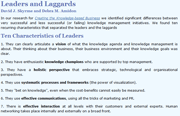Knowledge Commercialization
If knowledge is a valuable asset, then why not productize it and sell it on the open marketplace? After all, knowledge products and knowledge businesses are not new. While knowledge management is mostly focussed on improving knowledge flows within an organization, it is important not to overlook the potential for commercializing your unique knowledge that has value in the marketplace. We call this inside-out knowledge management, since there is a shift from an inward focus KM and knowledge processes to an external focus on knowledge businesses.
Types of Knowledge Business
Knowledge can be packaged and commercialized in many ways. Many of these involve some form of codification from tacit knowledge to knowledge in more explicit forms such as documents and databases, that are more readily distributed. What starts as uncodified knowledge, often a set of ideas, is gradually shaped through dialogue and expression into something more tangible, such as a process description or a product design, that finally emerges as products for sale.

Anywhere along this spectrum and more besides (see the diagram in KM Basics: Tacit Knowledge) represents an opportunity to create a knowledge-based product or service. Knowledge could be sold in the form of expertise, using your knowledgeable staff as consultants; it could be delivered as training courses, or packaged more explicitly into documents or databases.
Brewer (1999) has identified three main ways in which organizations commercialize their knowledge assets:
- Knowledge enriched products and services. An example is Zurich Financial Insurance's risk knowledge that has been packaged as its RiskIntelligence service.
- Advisory services. An example is that of British Telecom who sells knowledge management consultancy services based on its own internal experience.
- Publishing. An example is that of Best Practices LLC, a North Carolina consultancy that now makes significant revenues from selling best practice information globally over the internet.
There are, of course, many variants on these three main approaches.
Creating a Knowledge Business
The process of commercialization involves these stages:
- Identification of knowledge assets with commercial potential - this could well emerge from an internal KM programme as a result of conducting a knowledge audit.
- Understanding customers' needs and expectations - if the knowledge asset is used extensively internally, your internal customers will be a useful source of market intelligence, particularly if they have ever 'market tested' or benchmarked your internal offering against outside suppliers!
- Creating product and service packages - this may be anyting from a simple marketing brochure for more intangible services (e.g consultancy) to a well designed and tested package for an explicit knowledge product.
- Marketing the product - a key choice here is whether to go for high value low volume markets, or whether to package and price for volume.
- Continual adaptation of the product /service offering based on feedback - using knowledge creates new knowledge (see the knowledge cycle).
Creating a knowledge-based business is not without its challenges. The main ones are those often associated with marketing intangibles and services, /e/g how can you convince the potential customer of the quality of your offerings? Another one is the concern that selling internally beneficial knowledge externally will damage the core business. But this is often not the case. For example, Pilkington has made more money from licensing its float glass process to competitors than it would have done if it had kept it as internal knowledge.
Success Factors for a K-Business
Analysis of successful knowledge businesses, particularly those who market using the internet, indicate a number of success characteristics that we have encapsulated as a URL acronym:

In summary the seven factors are:
- Knowledge assets. A good choice of the knowledge or intellectual capital that is to be commercialized.
- Business concept. A sound core idea behind the business. It may be expressed as a vision statement or slogan, such as Ernst & Young's 'From Thought to FinishTM'. But in any case there must be a viable business model.
- Incubation. A suitable environment, either inside or outside the company, is needed to incubate the business concept from idea into fruition.
- Z-factor. The ingredient for scalability. Each strand of activity - packaging knowledge assets, developing a web presence, structuring the new organization and so on - must be developed in a coherent fashion, whilst being capable of rapid growth.
- Customer experience. The factors that create an enhanced customer experience. We suggest a three-layer grouping - the foundations, the customer-centred differentiators and the value-added enhancements.
- Operational excellence. All business processes, especially the order fulfilment cycle, must be efficiently managed to deliver excellent service and value to customers.
- Momentum. In the fast evolving knowledge economy and Internet environment, the need to continually reassess, and if necessary, reinvent your business, is an essential activity.
This success model is fully explained in the book Capitalizing on Knowledge (see below).
Notes and Further Reading
Brewer, T (1999), "Commercializing Knowledge", Knowledge Summit '99 Conference. London: Business Intelligence, November 1999.
'Commercialization: The Next Phase of Knowledge Management', David J. Skyrme, Chapter 63 in Handbook on Knowledge Management, ed. C. W. Holsapple, Springer-Verlag (2003).
Capitalizing on Knowledge: From e-business to k-business, David J. Skyrme, Butterworth-Heinemann (2001).
Last updated: 19th March 2011


